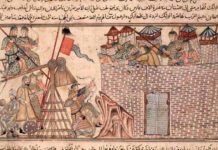US President Truman was preparing to abandon Korea when the NKPA invaded poorly armed South Korea triggering the 3-year UN led Korean war.
General Matthew B. Ridgway’s Korean War 1950-53 was relegated The Forgotten War by 1951. Tortuous negotiations between the US, CCF (Chinese Communists Forces) and NKPA (North Korean People’s Army) endured from July 1951 to July 1953 when the armistice came into effect.
General MacArthur C-in-C US Forces Far East
General Douglas MacArthur, the US pro-Consul in Japan, was indifferent to Korea. The Korean police force of 45,000 men, set up in 1946, could not defend or unify all of Korea. The United States maintained 45,000 men in South Korea, a wholly inadequate force.
Korea was a miserably poor, primitive, mountainous country with few paved roads and an inhospitable climate, jungle hot during the summer rainy season and arctic cold in winter. By May 1950 the ROK (Republic of Korea) army had grown to 100,000 men aided by US KMAG (Korean Military Advisory Group) advisors. Early in 1950 NKPA infiltrated nightly across the 38th Parallel. President Truman was preparing to abandon Korea as he had Chiang Kai-shek’s Formosa.
Korea invaded
In June 1950, US Captain Darrago, a conscientious KMAG officer based for six months at the 38th Parallel, reported the imminent NKPA invasion of South Korea. The NKPA border incursions suddenly ceased in May 1950 as they removed railroad tracks linking Kaesong with Pyongyang.
03.30hrs 24th June, Capt. Darrago witnessed a North Korean train jammed with infantry pulling into Kaesong station – they had secretly replaced the rail lines. Capt Darrago drove to Munsan alerting the 1st ROK Division HQ. The NKPA invasion of South Korea succeeded. The US 1st Cavalry Division, 24th Infantry Division and the 25th Infantry Division held for awhile at Taejon, then retreated to the defendable Pusan Perimeter by 5th August 1950. The US sent the 2d Inf Div and the USMC Bde on 5th August to reinforce the Pusan perimeter. General MacArthur landed an amphibious force at Inchon and swiftly recaptured Seoul, 25th September. The USMC Div, 187 Abn and the 7 Inf Div consolidated the Inchon bridgehead and linked up with 1 Cav Div from the Pusan bridgehead. South Korea was liberated.
The wrong way, the right way and the Ridgway
General MacArthur ordered General Ridgway to invade North Korea up to the Yalu river and the Chinese border. General MacArthur declared there were no CCF in Korea and UN forces could reunite the country. The Eight Army was combat ready, ably led by the battle experienced WW II paratrooper, General Ridgway. X Corps to the east was composed of ROK troops with USMC and 7 Inf Div in support.
Chinese offensive
The CCF with 19 armies of 480,000 men struck the extended UN forces between Eighth Army and X Corps 6th November 1950 at the Chosin Reservoir. X Corps retreated and were evacuated by sea from Hungnam 12th December. Seoul was threatened in favour of UN line D 6th January 1951. This defeat was humiliating. The CCF advanced against artillery and interlocked machine guns and levelled anti-tank guns inflicting tremendous losses on the CCF. Close air support decimated massed CCF infantry charges.
Yo-yo unwinnable war
CCF attacked in force 22nd April 1951 pushing UN forces back to the Seoul-Hoensong line. The Comm Bde (Commonwealth Brigade), Gloucester Regiment was annihilated north of Seoul. General MacArthur’s stated intention to use Chang Kai-shek’s forces to invade China, A-bomb Manchuria and massed CCF infantry staging areas ensured his dismissal by President Truman. The Korean War claimed two leading American political careers. Americans were sick of this yo-yo unwinnable war. General van Fleet replaced General Ridgway in charge of Eighth Army. General Ridgway replaced MacArthur in charge of the occupation of Japan and Commander-in Chief of US Far Eastern forces.
Armistice
The Battle and Armistice lines established 1st July 1951 on the Kansas/Wyoming lines held both north and south of the 38th Parallel and stabilised, while a year and a half of negotiations over Communist POWs followed. The Armistice was signed 10.00hrs 27th July 1953 at Panmunjon, Korea. The Big Switch of POWs followed. 12,773 UN prisoners including 945 Gloucesters were swapped for 75,823 Communist prisoners. 12,300 Americans were killed in Korea.
Source:
- The Forgotten War, America in Korea 1950-1953, Clay Blair, Anchor Books, 1989








